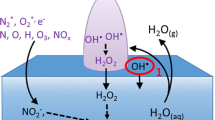Abstract
Oxidation of I-, Br∼, S2∼, Cr2+, and Mn2+ ions, as well as monochlorotriazine blue, in aqueous solutions was studied. The process was initiated by a steady-state discharge between a metal anode and an electrolyte solution. These reactions were found to be associated with active particles generated in both the gas-discharge plasma zone and the surface layer of the solution.
Similar content being viewed by others
Abbreviations
- A = ξLC = ln(J/J 0):
-
optical density of a solution
- C:
-
solute concentration, mol/1
- I:
-
discharge current, mA
- J o :
-
intensity of a light beam that enters the solution
- J :
-
intensity of the light beam that leaves the solution
- k :
-
bimolecular-reaction rate constant, mol-1 s-1
- L :
-
solution layer thickness (light beam path in the solution), m
- l:
-
distance between the anode and the solution surface acting as cathode, m
- t :
-
time, s
- U :
-
potential difference, V
- W :
-
discharge power, W
- /gx:
-
light wavelength, nm
- X :
-
molar extinction coefficient of the solution, l/(mol m)
- Τ:
-
plasma treatment time, s
- Ω:
-
rate of active particle generation in the solution subjected to a gas discharge, mol/s
References
Davies, R.A. and Hickling, A., Glow-Discharge Electrolysis. Part. 1 : The Anode Formation of Hydrogen Peroxide in Inert Electrolytes,J. Chem. Soc, 1952, no. 9, p. 3595.
Margulis, A.A. and Gavrilov, V.A., The Formation of Hydrogen Peroxide and Nitrogen Oxides in an Electrical Discharge and under Supersonic Cavitation in Distilled Water,Zh. Fiz. Khim., 1992, vol. 66, no. 3, p. 771.
Joshi, A.A., Locke, B.R., Arge, P., and Finney, W.C., Formation of Hydroxyl Radicals, Hydrogen Peroxide, and Aqueous Electrons by Pulsed Streamer Corona Discharge in Aqueous Solution,J. Hazardous Mat., 1995, vol. 41, no. 1, p. 3.
Hickling, A. and Linacre, J.K., Glow-Discharge Electrolysis. Part 2: The Anode Oxidation of Ferrous Sulphate,J. Chem. Soc, 1954, no. 2, p. 711.
Dinaro, A.R. and Hickling, A., Glow-Discharge Electrolysis in Aqueous Solutions,Electrochem. Soc, 1958, vol. 105, no. 5, p. 265.
Parkhomenko, V.D., Pivovarov, L.A., and Kravchenko, L.V., Oxamide Synthesis from an Aqueous Solution of Formamide in a Glow Discharge,Khim. Vys. Energ., 1990, vol. 25, no. 5, p. 466.
Ivanova, L.A., Kiselev, O.I., Ladvishchenko, Yu.M.,et al, USSR Inventor’s Certificate no. 1541216,Byull. Izpbret, 1990, no. 5.
Kutepov, A.M., Zakharov, A.G., and Maksimov, A.I., Physicochemical Properties of a Plasma-Solution System,Teor. Osn. Khim. Tekhnoi, 1999, vol. 33, no. 4, p. 357.
Scoog, D. and West, D.,Fundamentals of Analytical Chemistry, New York: Holt, Rinehart, Winston, 1976. Translated under the titleOsnovy analiticheskoi khitnii, Moscow: Mir, 1979.
Ksenzenko, V.l. and Stasievich, D.S.,Khimiya i tekhnologiya broma, ioda i ikh soedinenii (Chemistry and Technology of Bromine, Iodine, and Their Compounds), Moscow: Khimiya, 1979.
Author information
Authors and Affiliations
Rights and permissions
About this article
Cite this article
Kutepov, A.M., Zakharov, A.G. & Maksimov, A.I. Chemical processes initiated by a nonequilibrium plasma in solutions. Theor Found Chem Eng 34, 70–75 (2000). https://doi.org/10.1007/BF02757467
Received:
Issue Date:
DOI: https://doi.org/10.1007/BF02757467




